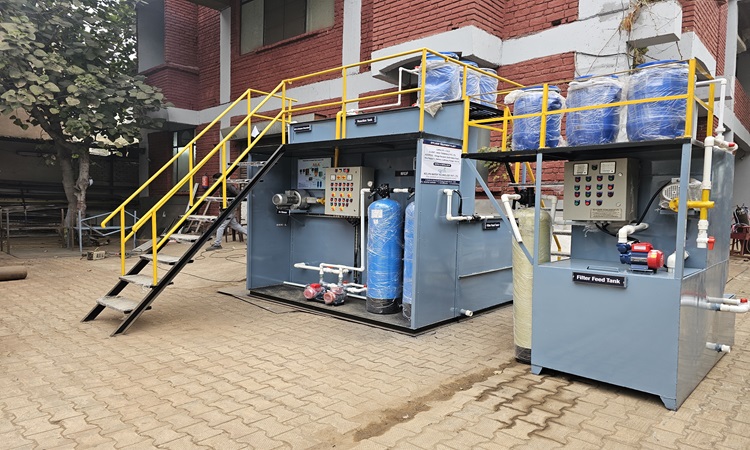Effluent Treatment Plant for Pharmaceutical Industry

The pharmaceutical industry is one of the fastest-growing and most critical sectors globally, responsible for producing essential medications, vaccines, and health-related chemicals. However, pharmaceutical manufacturing also generates a variety of complex liquid effluents containing high concentrations of organic and inorganic pollutants. To prevent environmental contamination and meet stringent regulatory standards, establishing a robust Effluent Treatment Plant is essential. An ETP specifically designed for the pharmaceutical sector ensures the safe treatment, recycling, and discharge of wastewater in compliance with CPCB, SPCB, and international discharge norms.
Introduction to ETP for the Pharmaceutical Industry
Pharmaceutical wastewater is highly variable and contains a wide range of toxic substances, including:
- Active Pharmaceutical Ingredients (APIs)
- Solvents
- Antibiotic and hormonal residues
- Suspended solids
- Toxic organic chemicals
- Heavy metals
- pH-imbalanced effluents
- High Chemical Oxygen Demand (COD) & Biological Oxygen Demand (BOD)
Characteristics of Pharmaceutical Wastewater
Pharma effluent differs from general industrial wastewater due to its complexity and variability. Typical characteristics include:
- High COD & BOD due to process chemicals
- Toxicity and mutagenicity from drug formulations
- Presence of antibiotics that may promote antimicrobial resistance (AMR)
- High TDS and pH fluctuation from chemical processes
- Potential carcinogenic and endocrine-disrupting compounds
Importance of Effluent Treatment in the Pharmaceutical Sector
a. Environmental Protection
Pharmaceutical wastewater can contaminate rivers, groundwater, and soil. A well-designed ETP prevents ecological damage by removing harmful chemicals and pathogens.
b. Regulatory Compliance
Government bodies such as CPCB and SPCB have strict guidelines for pharmaceutical effluent discharge. Non-compliance may lead to heavy penalties and shutdowns.
c. Corporate Sustainability
ETPs help industries reduce their environmental footprint and enhance sustainability credentials.
d. Water Reuse and Recycling
Modern ETPs enable the reuse of treated water for utilities like cooling towers, floor washing, and gardening, reducing freshwater dependency.
e. Protection of Public Health
ETPs prevent the release of pharmaceutical residues that can lead to antibiotic resistance and health hazards.
Treatment Processes Used in Pharmaceutical ETPs
A pharmaceutical ETP usually contains multiple stages combining physical, chemical, and biological processes to efficiently remove contaminants.
Preliminary Treatment
- Screening
- Oil and grease removal
- Equalization tank
These steps remove large solids and ensure uniform wastewater flow.
Primary Treatment
Involves physico-chemical processes such as:
- Coagulation & flocculation
- pH neutralization
- Sedimentation
These processes remove suspended solids and chemicals that are not biodegradable.
Secondary Treatment (Biological Treatment)
Biological processes reduce organic load (BOD/COD). Common technologies include:
A. Activated Sludge Process (ASP)
Uses microorganisms to decompose organic pollutants.
B. Moving Bed Biofilm Reactor (MBBR)
Highly efficient and compact, ideal for pharma waste with fluctuating loads.
C. Sequencing Batch Reactor (SBR)
Operates in batches, offering precise control over treatment parameters.
Combines biological treatment and membrane filtration; widely used in modern pharma ETPs due to high efficiency.
Tertiary & Advanced Treatment for Pharmaceutical Industry
Pharma wastewater often requires advanced treatment due to the presence of complex chemicals.
a. Activated Carbon Filters: Remove colour, odour, and organic chemicals.
b. Reverse Osmosis (RO): Removes dissolved salts and chemical impurities. Produces high-quality reusable water.
c. UV Treatment / Disinfection: Destroys microbes and ensures pathogen-free discharge.
d. Advanced Oxidation Processes (AOP)
Useful for breaking down persistent pharmaceutical compounds. Includes:
- Ozonation
- Fenton’s process
- UV + H₂O₂
e. Multi-Effect Evaporators (MEE)
Used for high TDS effluent; evaporates and separates dissolved impurities.
Typical ETP Process Flow for Pharmaceutical Wastewater
- Collection & Equalization
- Neutralization
- Coagulation & Flocculation
- Primary Clarification
- Aerobic/Anaerobic Biological Treatment (MBBR, SBR, ASP)
- Secondary Clarifier
- Activated Carbon Filtration
- RO or AOP System
- Sludge Treatment & Dewatering
- Final Discharge or Reuse
Key Features of a High-Quality Pharmaceutical ETP
- Robust design to handle variable effluent
- High chemical and biological removal efficiency
- Compact footprint
- Automated operation using PLC/SCADA
- Low sludge generation
- Energy-efficient blowers and pumps
- Corrosion-resistant tanks and piping
- Compliance with CPCB/SPCB norms
Benefits of Installing an Effluent Treatment Plant in Pharmaceutical Industry
1. Ensures Legal Compliance: Avoids legal action, penalties, and shutdowns.
2. Enhances Environmental Responsibility: Reduces pollution load and protects ecosystems.
3. Saves Water: Allows reuse of treated water, lowering operational costs.
4. Improves Corporate Image: Industries with sustainable practices gain trust and improved market reputation.
5. Reduces Operational Costs: Modern ETPs minimize chemical consumption and energy usage.
6. Prevents Antibiotic Resistance: Efficient treatment prevents harmful compounds from reaching water bodies.
Challenges in Treating Pharmaceutical Effluent
- High variability in effluent quality
- Presence of non-biodegradable chemicals
- Need for advanced treatment technologies
- Managing high TDS wastewater
- Controlling operational costs
Best Practices for Efficient ETP Management
- Regular monitoring of inlet and outlet water quality
- Scheduled maintenance of pumps, blowers, and membranes
- Proper sludge handling and safe disposal
- Using automated systems for better control
- Training ETP operators for efficient performance
Conclusion
Effluent Treatment Plants are a critical component of pharmaceutical manufacturing. With increasing environmental regulations and the growing need to protect natural resources, a well-engineered ETP ensures safe, compliant, and sustainable wastewater management. By adopting advanced technologies such as MBBR, SBR, MBR, RO, and AOP, pharmaceutical industries can achieve efficient treatment, reduce water consumption, and contribute to a cleaner and healthier environment.